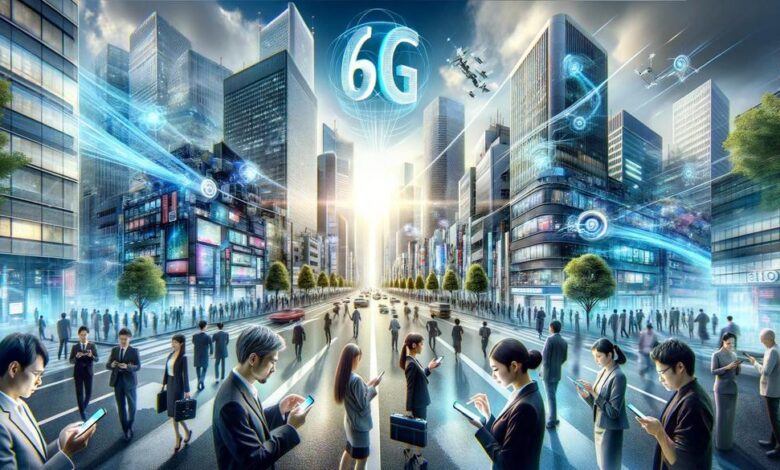Japan’s Breakthrough in Telecommunication Technology

Wireless communication is on the brink of a transformative leap, thanks to a consortium of Japanese telecommunication giants, including DOCOMO, NTT Corporation, NEC Corporation, and Fujitsu. These trailblazers have recently developed the world’s first 6G wireless device, capable of transmitting data at breathtaking speeds of 100 gigabits per second (Gbps)—a quantum leap that could transform how we connect, interact, and operate in the digital world.
Understanding the Basics: From 5G to 6G
Before diving into the intricacies of 6G, it’s crucial to grasp what it entails and how it stands apart from its predecessor, 5G. While 5G transmission occurs at frequencies below 6 GHz and expands into about 40 GHz (referred to as “millimeter-wave bands”), 6G leverages the higher-frequency “sub-terahertz” bands, ranging between 100 and 300 GHz.
The transition to these higher frequencies enhances data transmission speeds and presents unique challenges that necessitate innovative technological adaptations. For instance, 6G devices must be designed from scratch to operate effectively in these sub-terahertz bands.
Combining Technologies for the 6G Breakthrough
The development of the Japanese consortium’s first 6G wireless device doesn’t just exemplify collaborative innovation; it showcases how disparate technological advancements can synergize to create something revolutionary. At its core, the success of this device stems from the seamless integration of multiple technologies developed independently by DOCOMO, NTT, NEC, and Fujitsu.
DOCOMO’s expertise in wireless system configurations laid the groundwork. They developed an advanced framework that could handle ultra-high frequencies of 100 GHz efficiently. This framework was crucial as it provided a blueprint for incorporating high-frequency signal processing within manageable energy consumption levels. Simultaneously, NTT pioneered the development of robust 300 GHz devices, experimenting with and refining transmission characteristics to ensure stability and reliability over longer distances than previously achieved in practice.
From Signal Amplification to Antenna Design
The collaboration moved from theory to application as NEC and Fujitsu brought their specialized technologies into the fold. NEC’s development of a complex multi-element active phased array antenna was pivotal. The APAA system, with over 100 elements, was not just a standalone improvement; it significantly amplified the efficacy of signal distribution and reception that DOCOMO and NTT had developed. This antenna system could handle massive data loads at high speeds while maintaining signal integrity over extended distances.
The Active Phased Array Antenna (APAA) system engineered by NEC represents a significant technological advancement within the domain of 6G communications. This sophisticated antenna configuration utilizes over 100 individual elements that work together to dynamically control the direction and properties of the emitted radio waves. By adjusting the phase and amplitude of each element almost instantaneously, the APAA can direct its signal beams precisely, optimizing coverage and significantly enhancing data transmission rates.
This ability to focus and steer beams effectively allows the system to handle extensive data loads seamlessly, maintaining robust signal integrity even over greater distances. The APAA’s adaptability and precision make it an essential component in overcoming the challenges posed by the high frequencies and vast data requirements characteristic of next-generation wireless networks.
Meanwhile, Fujitsu’s advancements in compound semiconductor technologies provided the final piece in this intricate puzzle. They developed high-efficiency amplifiers that could boost the power of transmitted signals without a corresponding increase in energy consumption. This achievement was crucial in managing the inherent challenges of high-frequency 300 GHz and 100 GHz bands, facilitating a balance between range and power critical for the practical application of 6G technologies.
Insights into the First 6G Device
The landmark development of the first 6G device by the collaboration between Japanese tech giants NTT Docomo, NTT Corp., NEC, and Fujitsu is rooted in extensive research and novel engineering approaches specific to sub-terahertz technologies. This collaborative venture, initiated in 2021, has been laser-focused on harnessing the untapped potential of the 100 GHz and 300 GHz bands, pushing well beyond the limitations of existing 5G technologies.
The engineering prowess of these companies has been demonstrated through several key innovations. NTT Docomo spearheaded the effort by meticulously analyzing the wireless system configuration needed for the 100 GHz telecommunications applications. The result was a groundbreaking wireless transmission equipment capable of delivering speeds up to 100 Gbps across distances of up to 100 meters. This represents an extraordinary leap, being approximately 20 times faster than the current peak capabilities of 5G networks.
NTT tackled the challenges associated with the 300 GHz band, devising a unique device capable of transmitting equally impressive data rates within the same range. Their research ventured into developing complex components like wideband mixers to make this possible. Meanwhile, NEC’s focus lay on perfecting a multi-element active phased array antenna (APAA) for the 100 GHz band, which incorporated more than 100 antenna elements to manage and direct the wireless signals efficiently.
Fujitsu’s contribution was pivotal in the realm of signal amplification. Their research into compound semiconductor technologies led to the development of a high-output amplifier that claims the highest power efficiency worldwide. This advancement is crucial for extending communication ranges while significantly reducing power consumption, a critical factor for the practical application of 6G in various fields.
The Culmination of Collaborative Engineering
The convergence of these technologies—system configurations, high-frequency device development, complex antenna arrays, and efficient signal amplification—led to the creation of a device. This device is not only innovative but also scalable. Additionally, it is practical for future adaptations, showcasing its versatility and forward-thinking design.
Together, these integrated technologies form the backbone of a wireless device capable of operating effectively at the higher frequencies of the sub-terahertz band. The collaboration’s ongoing efforts point toward continued advancements and refinements aimed at overcoming the intrinsic challenges posed by these high-frequency bands. The joint R&D endeavors of these companies are set to play a crucial role in the standardization of 6G technology, heralding a new era of ultra-fast, reliable wireless communication systems poised for commercial launch circa 2030.
Every technological element not only synergized with the others but also significantly improved the system’s overall performance and efficiency. A major cooperative effort has expanded the limits of achievable wireless communication. This partnership underscores how effectively merging distinct specialized technologies under a shared vision can produce revolutionary progress in telecommunications. It paves the way for a future where the speed and dependability of data transmission and connectivity are unprecedentedly enhanced.
Potential Applications of 6G Technology
The development of 6G technology is a testament to human ingenuity and a gateway to myriad future possibilities. The ultra-high-speed and efficient data transmission facilitated by 6G could have sweeping implications across various sectors.
1. Ultra-HD Video Streaming
Imagine streaming high-definition movies or live events with no buffer time, where data flows as swiftly and smoothly as electricity in a cable. A seamless streaming experience, facilitated by 6G’s lightning-fast connectivity, promises to revolutionize our entertainment and media consumption, making interruptions a relic of the past. It opens up new possibilities for immersive virtual reality experiences and interactive live broadcasts, where every frame is delivered with pristine clarity and precision.
2. Real-time Autonomous Vehicle Communication
6G could enable vehicles to communicate with each other in real time, enhancing navigational systems and safety protocols, making driverless cars more efficient and safer. The heightened level of communication ensures that autonomous vehicles can synchronize and adapt to each other’s movements and the surrounding environment at microsecond speeds, drastically reducing the possibility of accidents. Additionally, it enables a smoother flow of traffic by allowing continuous and instant sharing of road conditions and traffic data among vehicles.
3. Advanced Urban Infrastructure Management
From managing traffic flows to monitoring urban environments in real time, 6G could revolutionize how cities operate and respond to emergencies. This technology can significantly enhance the responsiveness of emergency services by enabling quicker and more accurate data transmission, ensuring that critical information reaches the right destinations without delay. Moreover, it supports smarter urban planning and management by providing city officials with detailed, up-to-the-minute data on a wide range of urban metrics, from air quality to energy usage, facilitating more informed and timely decisions.
4. Remote Healthcare Services
With 6G, the possibility of conducting remote surgeries or real-time patient monitoring becomes more feasible, potentially transforming the healthcare industry. The massive leap forward in telecommunications could provide specialists with the ability to perform intricate medical procedures from miles away with near-zero latency, enhancing patient access to expert care irrespective of geographical barriers. Furthermore, real-time health monitoring enabled by 6G could lead to proactive healthcare management, allowing for immediate adjustments to treatment plans as patient conditions change.
5. Virtual Reality (VR) and Augmented Reality (AR)
The enhanced capabilities of 6G can push the bounds of VR and AR technologies, leading to more immersive and interactive experiences. Rapid data transmission enables seamless integration of real-world and digital content, creating a more fluid and realistic overlay of virtual elements in real environments—an advancement that could revolutionize education, entertainment, and professional training. Reduced latency and increased bandwidth of 6G could support multiple users in the same virtual space, fostering more dynamic and collaborative interactions in virtual meetings or multiplayer gaming scenarios.
Possibilities and Challenges of 6G Technology
As we stand on the precipice of this technological revolution, the question is no longer about the feasibility of such advanced technologies but about preparing ourselves for the myriad of opportunities and challenges they bring. The era of 6G will redefine digital connectivity, making what once seemed like science fiction a tangible, imminent reality.
As the horizon of 6G technology unfolds before us, it beckons not just technological advancements but also a reevaluation of data ethics, security protocols, and societal impact. It compels us to explore not just how we can harness its capabilities but also how we can do so responsibly and inclusively. The evolution into this new age of ultra-connectivity offers us a unique opportunity to build infrastructures that not only empower but also protect, ensuring that as we step into this future, it is accessible and secure for all. This moment is not just transformative—it’s pivotal, demanding careful thought and proactive planning to fully realize the beneficial potential of 6G.
Building a Responsible Framework Privacy in the 6G Era
In embracing these advancements, regulatory bodies, tech developers, and consumers must foster an environment that encourages innovation while also safeguarding privacy and security. Only by navigating these waters carefully can we fully leverage the potential of 6G to uplift and transform societies globally.
Collaborative effort between regulatory bodies, tech developers, and consumers is paramount in establishing a robust framework that accommodates rapid innovation while maintaining stringent security and privacy standards. These stakeholders must work hand in hand to set guidelines that not only spur technological growth but also prioritize ethical considerations and data protection. By creating a balanced ecosystem, we can ensure that the benefits of 6G technology are maximized across various sectors, contributing significantly to societal advancement while safeguarding individual rights and freedoms. This holistic approach is crucial as we venture into this promising yet complex new era of connectivity.
Shaping a New Era: Ethical Dimensions of 6G
As we marvel at Japan’s quantum leap into the 100Gbps connectivity of 6G, it is with a spirit of forward-looking optimism that we consider the broader implications of such a breakthrough. This isn’t just about faster internet speeds or more efficient data transmission—it’s about reimagining the parameters of digital connectivity and its potential to reshape societies.
The conversation around 6G, as it advances, will undoubtedly pivot towards how these technologies can be wielded for the common good, ensuring equitable access and fostering an inclusive digital future. How we choose to navigate this new landscape will be crucial in determining the role technology plays in our collective future, balancing unprecedented capabilities with the requisite responsibility.
The path we carve from here—fueled by innovation and guided by ethical stewardship—will set the tone for the next great epoch of technological advancement. In this transformative journey, the question remains not just of what technology can do but what it should do to better the world.



